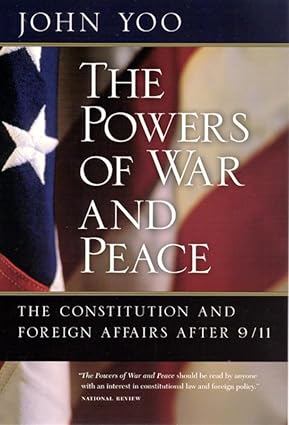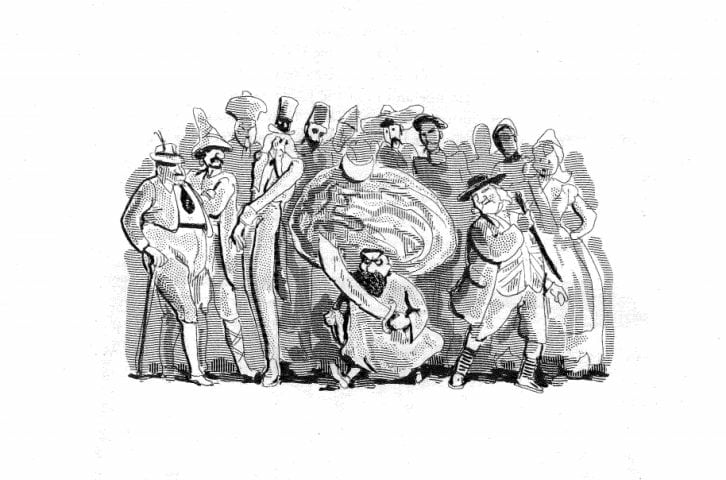Books Reviewed
During the recent senate hearings on Judge Samuel Alito’s nomination to the Supreme Court, Senator Joseph Biden pressed Alito to denounce John Yoo’s controversial defense of presidential initiative in taking the nation to war. Alito was noncommittal. Biden rightly observed that many constitutional scholars hold that Congress must authorize most, if not all, significant military actions by the United States abroad. Yoo, on the other hand, maintains, as he first argued in a seminal 1996 law review article, that the president has full constitutional authority to act initially and that Congress, after the fact, can check executive folly by denying the president the means to conduct war and, in extreme cases, by impeaching and removing him from office.
A professor of law at the University of California at Berkeley and visiting scholar at the American Enterprise Institute, Yoo served from 2001 to 2003 in the Office of Legal Counsel in the U.S. Department of Justice. There he did much to fashion the Bush Administration’s expansive view of the president’s independent constitutional authority in the war on terrorism. The first half of The Powers of War and Peace is Yoo’s mature statement concerning the relative constitutional powers of the president and Congress to initiate and sustain military hostilities. The second half focuses on key constitutional issues regarding the treaty power, including whether the president may unilaterally suspend or terminate treaties (according to Yoo, he may), whether treaties are “self-executing” (they are not) or require positive legislation to have domestic effect (they do), and whether international agreements endorsed through the normal legislative process (“congressional-executive agreements”) may substitute for formal treaties, which require two-thirds of the Senate to agree but not the House of Representatives (they may not). In Yoo’s view, getting the Constitution right with respect to the war and treaty powers is vitally important in a post-9/11 world threatened by international terrorist organizations and rogue regimes, and in which critical policy issues—such as arms control, human rights, and environmental protection—are increasingly subject to international law and organizations.
All agree that the president, on his own authority, may respond militarily to attacks on the United States. At the Philadelphia Convention, an early draft of the Constitution had given Congress the power “to make war.” When this clause came before the delegates, James Madison of Virginia and Elbridge Gerry of Massachusetts proposed changing “make” to “declare,” “leaving to the Executive the power to repel sudden attacks.” The change was made and not revisited. Similarly, the draft constitution made the president the “commander in chief of the Army and Navy of the United States, and of the Militia of the Several States.” Without objection (or indeed any substantive debate), the commander-in-chief clause made its way into the Constitution.
How best to understand this division of authority? Some argue that Congress must authorize all uses of military force other than self-defensive measures. “[T]he power to repel sudden attacks” is, then, the single exception to the rule of congressional prior approval. This view is buttressed by the fact that Congress is also given the power to “grant Letters of Marque and Reprisal,” by which government may authorize private parties to use force in limited ways against foreign nations or individuals under the color of law. If captured, those using force would be treated as prisoners of war, rather than as pirates, murderers, or robbers. Many scholars take the assignment of this power to Congress as further evidence that the framers expected Congress to authorize all military conflicts, from full-fledged wars down to limited reprisals.
Yet, as Yoo notes, “the United States has committed military forces into hostilities abroad at least 125 times” in the Constitution’s history. In only five of these cases did Congress declare war. In some others (such as the 1798 Quasi-War with France, the Vietnam War, the 1991 Persian Gulf War, and the 2003 invasion of Iraq) Congress authorized military action without formally declaring war. Most often, however, military force was used without prior congressional approval. A recent example is the 1999 air war in Kosovo and Serbia (to which Yoo devotes several pages), which was conducted under NATO’s auspices but that Congress refused to authorize in advance. In short, historical practice diverges sharply from the dominant scholarly view of what the Constitution requires.
* * *
One way to reconcile actual practice with the Constitution would be to recognize an inherent authority in the president—as commander in chief, holder of the “executive power,” and the organ of foreign relations—to use the military for limited purposes, such as protecting American citizens or property on the high seas or overseas, serving in peacekeeping or other humanitarian missions, fulfilling treaty obligations, or otherwise protecting the nation’s vital interests. Under this more expansive view, presidents could do much on their own authority, up to, but not including, engaging in a large-scale or protracted war with another nation. Such a view would accept the legality of nearly all uses of military force throughout U.S. history (whether or not authorized by Congress), but would draw the line at a conflict like the Korean War, which lasted three years and resulted in more than 33,000 American combat deaths—and was never formally authorized by Congress.
According to this view, military actions that involve hundreds or perhaps a few thousand troops (but certainly not hundreds of thousands) and that can be accomplished in days, weeks, or a few months (but not many months or a year or more) could well pass constitutional muster in the absence of prior congressional approval. If this seems woefully imprecise, it nonetheless accords, its proponents argue, with the Constitution’s inherent flexibility, which was intended to allow the president to protect the nation’s interests in a hostile world. It is also broadly consistent with Congress’s own 1973 War Powers Resolution which, though it defines the president’s war-making powers quite narrowly in its “Purpose and Policy” section, does not actually require the president to receive congressional approval before acting militarily and permits military engagements to continue for two to three months without specific authorization. (A provision that allowed the House and Senate to force the end of military action at any time by a simple majority vote of both bodies—not subject to a presidential veto—was effectively ruled unconstitutional in an unrelated case in 1983 that overturned all such “legislative vetoes.”)
As noted, this approach would permit much, but not all, that a president might like to do militarily without seeking congressional authorization. Retaining the power to “declare war,” Congress must approve in advance the movement of the United States from peace to war, even if that war is not a “total” or “perfect” war like World War II. Conflicts like the Korean War, the Vietnam War, the Persian Gulf War, and the invasion of Iraq all required (and all but the first received) formal congressional authorization. But lesser military interventions—such as the 1983 invasion of Grenada, the 1986 bombing of Libya, the 1989 intervention in Panama, the 1992-1994 relief mission to Somalia, and the several military interventions in the former Yugoslavia in the 1990s—do not necessarily activate the “declare war” power of Congress (though Congress may weigh in after the fact through its appropriations power). The presumption here is that Congress’s power to “declare war” is equivalent to the power to authorize or commence war, but not the power to authorize or commence any and every use of force abroad. The key, then, is distinguishing between “real” wars and lesser military interventions.
John Yoo’s intriguing argument is that this is the wrong way to think about the meaning of Congress’s power to declare war because “the Framers did not understand the phrase ‘declare war’ to amount to the power to ‘make war’ or ‘commence war.'” Instead, declarations of war “make public, show openly, and make known the state of international legal relations between the United States and another nation.” In so doing, they clarify the rights and responsibilities of the nation’s own citizens, neutral nations, belligerents, and other parties under the “law of nations.” Moreover, under current U.S. law, declarations also activate the president’s special domestic powers, such as seizing foreign property and arresting enemy aliens. “Even the Supreme Court has suggested that in times of declared war, certain actions by the federal government would survive strict scrutiny but would certainly fail if attempted in peacetime.”
Yoo presents an impressive body of evidence that neither those who wrote the Constitution nor those who ratified it understood that the president would need Congress’s approval before engaging military forces abroad. British constitutional and political history “formed the context within which the Framers would have understood the new Constitution,” writes Yoo. Under that history, the full power to engage the nation in war resided in the Crown—that is, the executive. Parliament checked the king principally through control over appropriations and, in some cases, impeachment of ministers. During this period the leading authorities on the law of nations understood declarations of war to be legal pronouncements not necessary to authorize hostilities. In fact, the two political theorists who most influenced the founding generation—John Locke and the Baron de Montesquieu—agreed that the power over war and peace was executive in nature. Britain’s preeminent jurist and legal commentator, William Blackstone, agreed.
Throughout the 17th and 18th centuries, Britain engaged in some wars that were not declared at all (hence Alexander Hamilton’s comment in Federalist 25 that “the ceremony of a formal denunciation of war has of late fallen into disuse”) and others that were declared only some time after hostilities had begun. The framers would have known, for example, that hostilities in the Seven Year’s War, in which many colonists served, began in North America two years before Britain formally declared war on France in May 1756.
* * *
In their first constitutions, Yoo notes, all but one of the states “gave the governor the exclusive power to decide when to use the militia or required that he consult the [executive] council [but not the legislature] before calling forth the military.” In Virginia, for example, the state constitutional convention rejected Thomas Jefferson’s proposed language that expressly denied the governor the power to “declare war or peace, issue letters of marque or reprisal, [or] raise or introduce armed forces.” According to Yoo, “The exception ‘that proves the rule'” was “South Carolina’s radically different” approach in its constitutions of 1776 and 1778. Although the first made the governor “commander-in-chief,” it stipulated that he “shall have no power to make war or peace…without the consent of the general assembly and legislative council.” No other state imposed such a restriction. The revised 1778 constitution was even clearer: “the governor and commander-in-chief shall have no power to commence war, or conclude peace” without the approval of the legislature.
Similarly, both the Articles of Confederation and the U.S. Constitution prohibited the states from “engag[ing]” in war without the consent of Congress unless actually invaded or in imminent danger of invasion. As Yoo insists, constitution makers at the time of the founding knew how to require legislative authorization for military actions when they wished it. Yet they imposed no such explicit restriction on the American presidency. During the debate over the Constitution’s ratification, some Anti-Federalists complained of an overly powerful presidency; yet as Yoo shows, in states such as Virginia, “Federalists never described Congress’s power to declare war as a check on the president, even though it was very much in their interest to do so” (emphasis in the original). In using the phrase “declare war” and vesting this power in Congress, the Constitution’s drafters rejected the alternatives “make war” (1776 South Carolina Constitution), “commence war” (1778 South Carolina Constitution), “engage in war” (the Constitution’s prohibition on the states), and “levying war” (part of the Constitution’s definition of treason). Why? Because “[a]t the time of the Constitution’s ratification ‘declare’ carried a distinct and separate meaning from ‘levy,’ ‘engage,’ ‘make,’ or ‘commence.'”
Yoo concludes from all this (and more) that “the president…has the domestic constitutional authority to initiate military hostilities without any authorizing legislation.” Perhaps the signal contribution of The Powers of War and Peace is this assemblage of compelling evidence in defense of the president’s constitutional authority to take the initiative in the use of force abroad.
Yoo recognizes, however, that not all the evidence from the founding period supports his expansive view of presidential power. Other scholars cite leading framers such as James Wilson, James Madison, and even Alexander Hamilton to support congressional preeminence in decisions to go to war. Some part of Yoo’s analysis addresses this evidence, but he leaves the reader wishing for more. For example, in his famous exchange with Madison in 1793 on presidential power (the Pacificus-Helvidius debates) Hamilton wrote:
While, therefore, the legislature can alone declare war, can alone actually transfer the nation from a state of peace to a state of hostility, it belongs to the ‘executive power’ to do whatever else the law of nations, cooperating with the treaties of the country, enjoin in the intercourse of the United States with foreign powers.
Only Congress, Hamilton acknowledges, can “actually transfer the nation from a state of peace to a state of hostility.” Here Hamilton seems to read “declare” war as equivalent to “make” or “commence” war. Although Hamilton’s formulation does not require that all uses of force must be pre-approved by Congress, it does suggest that Yoo’s view is even more expansive than that of one of the founding generation’s foremost proponents of a powerful constitutional presidency.
Perhaps Yoo would respond that Hamilton was using the phrases “state of peace” and “state of hostility” in the legal sense denoted by the power to “declare war.” Perhaps Hamilton was intentionally playing upon the ambiguity of the phrases, leading the reader to think one thing when something more limited was meant. In his analysis of Federalist 69, for example, where Hamilton argues that the American president will have less war-making power than the British king, Yoo concludes that Hamilton engaged in “rhetorical excess” and perhaps intentional ambiguity. We should not, after all, be surprised if rhetorical demands occasionally trump theoretical precision. Nonetheless, one wonders whether the Hamilton of the Pacificus essays would have argued, as Yoo does, that the president does not need formal congressional authorization to commit American forces to conflicts like Korea, Vietnam, the Persian Gulf, and Iraq.
Under Yoo’s interpretation of the Constitution is there any limit to the scale of military conflicts that the president on his own authority may initiate? As Senator Biden asked Judge Alito, does the president, for example, have the constitutional authority to invade Iran without congressional approval? It is not surprising that Senator Biden and those who advise him concluded that Yoo places no limits on presidential initiative. After all, Yoo asserts that “the president…has the domestic constitutional authority to initiate military hostilities without any authorizing legislation”; that the Constitution provides for “unilateral presidential warmaking”; that “[w]ith large militaries designed to project overwhelming force throughout the world at his disposal, the president as commander in chief holds the initiative to use force abroad”; and that Congress’s control over appropriations “renders unnecessary any formal process requirement for congressional authorization or a declaration of war before hostilities may begin.” Insofar as Congress can check presidential war-making—Madison as Helvidius had written that “[w]ar is…the true nurse of executive aggrandizement”—it is only after the fact.
* * *
Despite Yoo’s emphatic defense of “unilateral presidential warmaking,” there appear to be some limits, by his own account, to what presidents may lawfully do. “A declaration of war,” he writes, “only perfected, or made ‘completely effectual,’ hostilities between two nations…. [A] ‘declared’ war was only the ultimate state in a gradually ascending scale of hostilities between nations.” Thus, when the framers changed Congress’s power from “make war” to “declare war,” they “set a limit” on presidential power: “the president could not unilaterally take the nation into a total war, but…he might be able to engage the nation in hostilities short of that.” The constitutional language “prevented the president from unilaterally igniting a total war, yet simultaneously barred Congress from encroaching on his exclusive authority to conduct hostilities short of that.” It appears, then, that the president is not allowed to commence “total war,” because only Congress may “declare war.” If this is right, then only Congress may commence, or authorize the commencement of, total war. Can we conclude that if the issue is total war, then to “declare” war is, in fact, equivalent to “levy,” “engage in,” “make,” or “commence” war?
This conclusion seems to shift the debate from the difference between “declare” and “commence” to the difference between “total war” and “hostilities short of that.” Would, for example, an invasion of Iran to change the regime, eliminate the nuclear threat, and establish a liberal democracy there involve the kind of “total war” that, apparently, only Congress can authorize, or would such actions amount merely to “hostilities short of that”? What Hamilton wrote in 1787 could well be said today: “the ceremony of a formal denunciation of war has of late fallen into disuse.” It has been more than 60 years since the U.S. formally declared war against anyone; yet during that time the nation has engaged in more than a few conflicts that we consider wars, including at least the Korean War, the Vietnam War, the Persian Gulf War, and the Iraq War. In each case there were prudential reasons for not declaring war; nonetheless, Congress formally authorized all but the first. One might think of these authorizations as the functional equivalent of a declaration of war.
If these conflicts fall short of what we call “total war” (such as World War II), they seem in scope and duration to rise to the level of hostilities that, according to Blackstone, “a denunciation of war ought always to precede…[so] that it may be certainly clear that the war is not undertaken by private persons, but by the will of the whole community…. [I]n order to make a war completely effectual, it is necessary…that it be publicly declared and duly proclaimed…; and, then, all parts of both the contending nations, from the highest to the lowest, are bound by it.” Need a war be “total” in order to be made “completely effectual”? And doesn’t a joint resolution formally authorizing war make the conflict “completely effectual” in a legal sense? If so, then the limit placed on presidential war-making by the Constitution may be something less than “total war,” as that phrase is conventionally understood.
American history confirms that there are many times when it is necessary to project force beyond the nation’s borders. Often this must be done too quickly or too secretly to obtain congressional approval in advance. If the Constitution does not provide for such energetic executive actions, then we must either pay the costs of inaction or do what has to be done as an “emergency” measure outside the Constitution. John Yoo sides with the framers in rejecting both alternatives. He recognizes, as Hamilton wrote in The Federalist, that “[t]he circumstances that endanger the safety of nations are infinite, and for this reason no constitutional shackles can be wisely imposed on the power to which the care of it is committed.” A well-written constitution must be equal to “a struggle with public necessity.” Otherwise, leaders will violate the law whenever necessity requires. The danger of taking extra-constitutional (or unconstitutional) “emergency” actions, Hamilton warned, is that “every breach of the fundamental laws, though dictated by necessity, impairs that sacred reverence which ought to be maintained in the breast of rulers towards the constitution of a country, and forms a precedent for other breaches where the same plea of necessity does not exist at all, or is less urgent and palpable.”
Although Yoo seems to go beyond even Hamilton in what he would allow presidents to do under the Constitution, he makes a compelling case that Congress need not formally authorize many, perhaps most, military commitments abroad, for which the president possesses ample constitutional authority. It is rare that one scholar fundamentally recasts the debate on a constitutional issue of pressing public importance. In The Powers of War and Peace, John Yoo has done exactly that.







